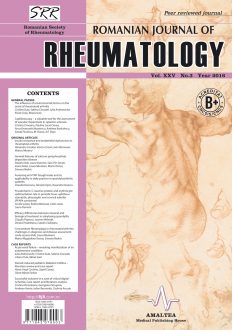SELECT ISSUE

Indexed

| |

|
|
|
| |
|
|
|

|
|
|
|
|
|
| |
|
|
HIGHLIGHTS
National Awards “Science and Research”
NEW! RJR has announced the annually National Award for "Science and Research" for the best scientific articles published throughout the year in the official journal.
Read the Recommendations for the Conduct, Reporting, Editing, and Publication of Scholarly work in Medical Journals.
The published medical research literature is a global public good. Medical journal editors have a social responsibility to promote global health by publishing, whenever possible, research that furthers health worldwide.
General features of calcium pyrophosphate deposition disease
Paulina Vele, Laura Damian, Simon Siao-Pin, Ioana Felea, Laura Muntean, Maria Tamas and Simona Rednic
ABSTRACT
Background. Calcium pyrophosphate deposition (CPPD) disease is due to deposition of calcium pyrophosphate to hyaline cartilage, fibrocartilage and soft tissues. Clinical presentation may be as acute arthritis, chronic arthritis and associated with osteoarthritis. CPPD can be idiopathic or secondary, due to different metabolic diseases.
Objectives. The aim of this study was to evaluate the clinical characteristics, secondary causes and risk factors of symptomatic CPPD.
Material and methods. Patients diagnosed with CPPD upon presentation for joint pain and/or limitation of motion in Cluj-Napoca Rheumatology Department, were prospectively included in the study. Demographic data, clinical features, laboratory parameters for secondary causes of CPPD and risk factors were recorded.
Results. The study included 40 patients with CPPD. A percentage of 70% patients presented with acute arthritis. The knee was the most affected joint. During the assessment for secondary CPPD, three patients with hypomagnesaemia and one patient with hypophosphatasia were found. Screening for alkaptonuria was negative in all patients tested (30 patients). Regarding risk factors, 65% of patients were over 60 years old, osteoarthritis was associated in 80% of cases, joint injury in 2%, meniscectomy in 6%, diuretics use in 18%, family history of CPPD 2%.
Conclusions. Acute arthritis of the knee is the most frequent form of CPPD presentation. Ageing and osteoarthritis are common risk factors for CPPD. Although secondary causes of CPPD are rare, screening is very important.
Keywords: CPPD, clinical features, secondary causes, risk factors
